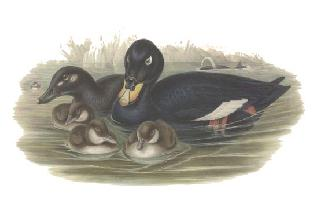
Starea de conservare
| Neînfricat |
Descrierea animalului
The Common Scoter (Melanitta nigra) is a captivating species of sea duck, primarily found across the northern reaches of Europe and Asia, with its range extending to the eastern parts of North America for the American subspecies (Melanitta americana), often referred to as the Black Scoter. This bird is a marvel of adaptation, thriving in both freshwater and marine environments, showcasing a remarkable resilience and versatility in its habitats.Adult males of the Common Scoter species are predominantly recognized by their striking jet-black plumage, which serves as a dramatic contrast to their surroundings, especially during the breeding season. One of the most distinctive features of the male is its bulbous bill, which is not only large but also uniquely adorned with a prominent yellow knob at the base, making it an unmistakable identifier among sea ducks. The females and juveniles, in contrast, wear a more subdued attire; they are cloaked in a dark brown plumage, which provides excellent camouflage against predators when nesting on the ground or foraging in their aquatic environments.
The Common Scoter measures approximately 43-54 cm in length, with a wingspan that can stretch from 79 to 90 cm, showcasing a robust and sturdy build. Despite its somewhat bulky appearance, this bird is an adept flyer, capable of long migratory journeys, and an even more skilled diver. It feeds primarily on aquatic organisms, diving deep into cold waters to forage for mollusks, crustaceans, and small fish, using its specially adapted bill to sift and grasp its prey.
Breeding typically occurs in the secluded northern lakes and wetlands, where the female constructs a shallow nest on the ground, meticulously lined with vegetation and down. The clutch usually consists of 6-8 eggs, which the female incubates alone, demonstrating a strong maternal instinct and dedication to her offspring. The ducklings are precocial and are able to leave the nest shortly after hatching, quickly becoming adept swimmers under the watchful eye of their mother.
The Common Scoter communicates through a variety of vocalizations; the male emits a distinctive, melancholic whistle, especially during the mating season, while the female responds with a softer, more subdued call. These vocal exchanges play a crucial role in the social and breeding behaviors of the species.
Conservation efforts for the Common Scoter are ongoing, as its populations face threats from habitat loss, pollution, and climate change. Although it is classified as "Least Concern" by the International Union for Conservation of Nature (IUCN), the species has seen declines in specific areas, prompting conservationists to monitor its status closely and work towards mitigating the impacts of human activity on its natural habitats.
In conclusion, the Common Scoter is a fascinating and resilient bird, embodying the harsh beauty of the northern landscapes it inhabits. Its unique characteristics, from the striking appearance of the males to the hardiness and maternal dedication of the females, make it a remarkable species
Animale similare
Fotografii noi cu animale
Top 10 animale
- Dolphin gull (Leucophaeus scoresbii)
- Diana monkey (Cercopithecus diana)
- Moustached guenon (Cercopithecus cephus)
- Galápagos tortoise (Geochelone nigra complex)
- Stone loach (Barbatula barbatula)
- Greek tortoise (Testudo graeca)
- Japanese macaque (Macaca fuscata)
- Russian tortoise (Testudo horsfieldii)
- Common flying dragon (Draco volans)
- Galápagos penguin (Spheniscus mendiculus)


